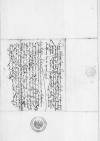Letter #5209
Ioannes DANTISCUS to Albrecht I von Hohenzollern-AnsbachHeilsberg (Lidzbark Warmiński), 1539-03-19
| received 1539-03-21 Manuscript sources:
Auxiliary sources:
Prints:
| ||||||||||
Text & apparatus & commentary Plain text Text & commentary Text & apparatus
 GStA PK, HBA, C1, No 557 2 unnumbered
GStA PK, HBA, C1, No 557 2 unnumbered
Dem durchlauchten, hochgebornen fursten und hern, hern(n)
 GStA PK, HBA, C1, No 557 1 unnumbered
GStA PK, HBA, C1, No 557 1 unnumbered
Durchlauchter, hochgebornner furst, hochgunstiger, lyber herr unnd freundt. / Unnser freuntliche, wÿllige dinnst zuvorann(n).
Uns hat der hochwirdige in Gott unser freuntlicher, lÿber bruder der her
Wir haben auch schrifft von hove, / welche uns warlich betrubt, / wÿ E(wer) F(urstliche) D(urchlauch)t guther diner der her
Das under kantzler ampt mit dem sigel ÿst herrn
Datum(m)

